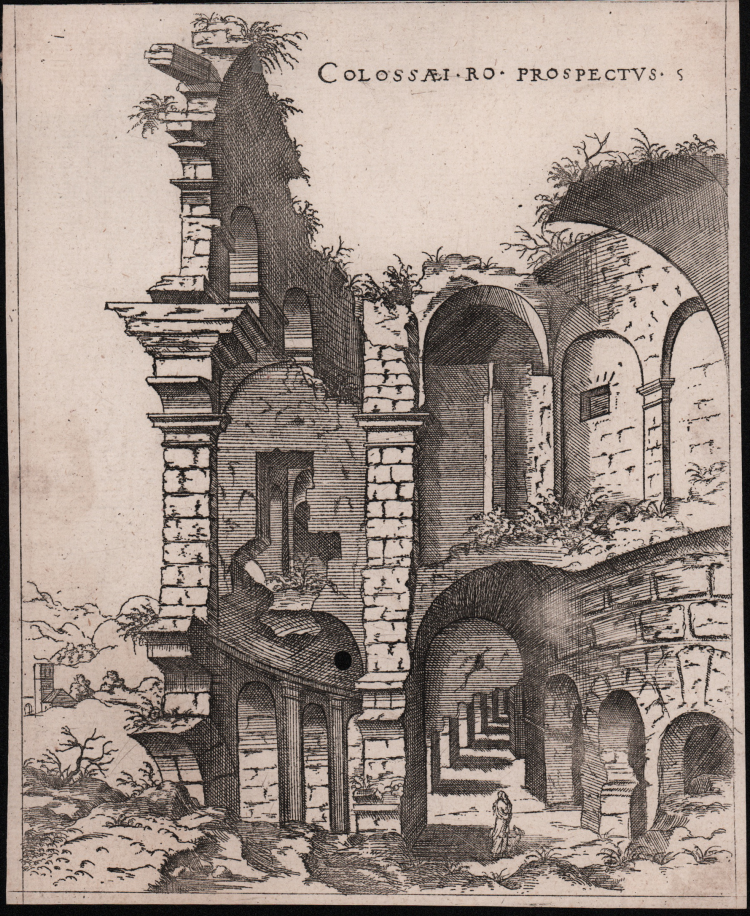



| Reference: | S39885 |
| Author | Jacques Androuet du CERCEAU |
| Year: | 1555 ca. |
| Printed: | Antwerpen |
| Measures: | 148 x 182 mm |


| Reference: | S39885 |
| Author | Jacques Androuet du CERCEAU |
| Year: | 1555 ca. |
| Printed: | Antwerpen |
| Measures: | 148 x 182 mm |
Etching, circa 1555, lacking editorial indications. Work belonging to the exceedingly rare series Praecipua aliquot Romanae antiquitatis ruinarum monimenta vivis prospectibus ad veri imitationem affabre designate, attributed to the hand of Jacques Androuet Du Cerceau.
This is a series of engravings based on the work of the same name by Hieronimus Cock, printed in Antwerp in 1551 (frontispiece and 24 plates).
“All ruins bespeak both persistence and decay. Yet the specificity of Roman ruins, for the Antwerp publisher Hieronymus Cock (c. 1510—1570), lay less in a charged sublimnity than in a lingering power to model, to furnish templates in his Netherlandish here-and-now. Cock's astonishing series of etchings, the Praecipua Aliquot Romanae Monimenta was published in 1551. One of the earliest products of Cock's revolutionary Aux Quatre Vents firm, the Praecipua has long proven problematic to art historians, since it seems less to document ancient Rome than to present the city as landscape, a sprawl of disabled structures. Writing in 1907, for example, the archaeologist Hülsen complained that Cock's views 'teach us nearly nothing' of antiquity, and 'depict only how grave the monuments' "en-rubblement" (Verschüttung) has become'. Yet the sixteenth-century appeal of Cock's prints lay precisely with this enactment of decay. For his audiences Cock fragmented views of the Colosseum, blurred distances between buildings like the Septizodium and the Baths of Diocletian and dotted the ruins with tiny animals and human figures. Ultimately, the etchings mattered not as antiquarian documents but as pattern prints, templates re-used and excerpted by German intarsists, Dutch metalsmiths, and Italian painters. It was the print medium that enabled such copia to reconstruct a Rome that was no longer there, less by showing it than re-staging via a kind of antiquarian virtuality, its aesthetic of bricolage” (cf. Christopher P. Heuer, Hieronymus Cock's Aesthetic of Collapse, pp. 387, 389-408, Oxford 2009).
The Du Cerceau series is a faithful reduction of Cock's engravings. It should consist of 24 plates, but its extreme rarity - there are no complete set of the collection, but only very few small collections of the plates (13 plates, including the frontispiece, are preserved in Rome, BIASA [Rari I 93]) - does not allow us to establish this with certainty.
Beautiful proof, printed on contemporary laid paper, trimmed to the platemark, woodworm hole in lower part, otherwise in perfect condition. Exceedingly rare.
Literature
Inventaire du fonds français 1932, v. I, p. 53; Les Du Cerceau, leur vie et leur oeuvre, d'après de nouvelles recherches par le baron Henry de Geymüller (1887); Jean Guillaume, Peter Fuhring Jacques Androuet du Cerceau: un des plus grands architectes qui se soient jamais trouvés en France, Parigi, 2010; H. Coch, The Reinassance in Print, pp. 90-103; Christopher P. Heuer, Hieronymus Cock's Aesthetic of Collapse, pp. 387, 389-408.
Jacques Androuet du CERCEAU (Parigi circa 1520 – Ginevra 1586 circa)
|
Jacques du Cerceau, architect and prolific engraver, had a great importance on the propagation of the Italian Renaissance decorations in France. He was particularly attracted by the decorations and the ornamental stuccos of Palazzo of Fontainbleu, realized by Rosso Fiorentino and Primaticcio, drawing inspiration from them, instead that from the frescos. Between 1550 and 1570, he published many collections of friezes and decorations, inspired to the different rooms of the palace; his works, such as the Livre de Grotesques (1566), contribute in a very important way to reconstruct the location of the fresco in the Galleria d’Ulisse of the palace, which had been destroyed in 1738/39. His engravings have been fundamental for the following centuries.
|
Jacques Androuet du CERCEAU (Parigi circa 1520 – Ginevra 1586 circa)
|
Jacques du Cerceau, architect and prolific engraver, had a great importance on the propagation of the Italian Renaissance decorations in France. He was particularly attracted by the decorations and the ornamental stuccos of Palazzo of Fontainbleu, realized by Rosso Fiorentino and Primaticcio, drawing inspiration from them, instead that from the frescos. Between 1550 and 1570, he published many collections of friezes and decorations, inspired to the different rooms of the palace; his works, such as the Livre de Grotesques (1566), contribute in a very important way to reconstruct the location of the fresco in the Galleria d’Ulisse of the palace, which had been destroyed in 1738/39. His engravings have been fundamental for the following centuries.
|